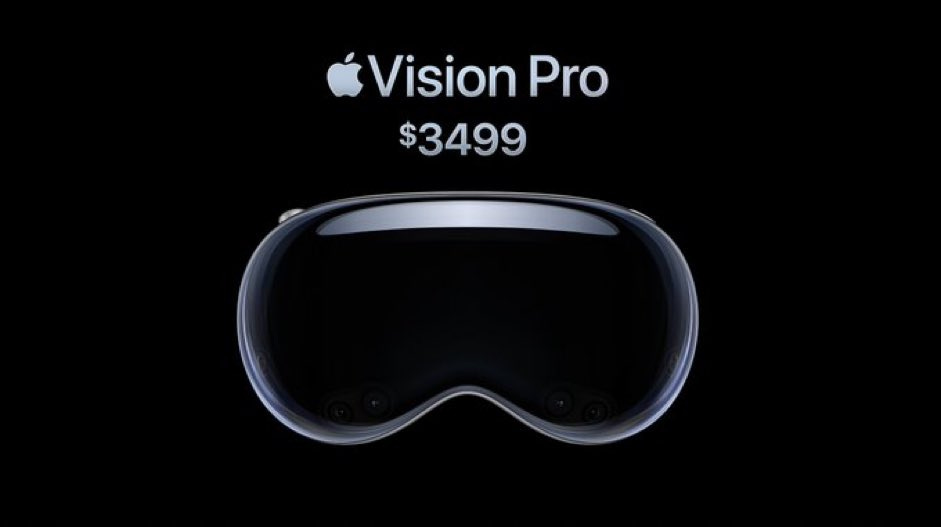After months of rumor and speculation, Apple’s Vision Pro headset was finally revealed during the keynote video it used to kick off the 2023 Worldwide Developers Conference. Earlier in the event, Apple showed off a new feature for iPhone and iPad designed to encourage users to move their screens a bit further from their faces to reduce eye strain and the risk of developing nearsightedness — but those concerns appeared to have disappeared by the time the Vision Pro and its two screens directly in front of users’ eyes took the (virtual) stage.
The Vision Pro looks sleek in an Apple-y way, but it also looks pretty ridiculous. The company clearly imagines us wearing this headset throughout our days and interacting with people as if there isn’t a large device strapped to our heads, occasionally displaying an eery representation of our eyes. That feature is designed to show the headset isn’t isolating, and is rather an “augmented reality” piece of hardware. While I’m sure the distinction between augmented and virtual reality matters to some people, what I observed in the presentation was just how little difference it makes.
Apple showed off many potential use cases for the Vision Pro: doing work at home, watching a movie, doing work at the office, shielding yourself from other passengers on a plane, and doing work on the road. The company mentioned games, but didn’t make it a focus, despite that being a major use case for comparable products. The emphasis was on work and the notion that it should be normal to wear a headset throughout your day. You can understand the emphasis on work, especially given the headset’s price tag (which we’ll get to later), but ultimately if this is the direction computing is set to go in the next ten or fifteen years, we’re in for an even more dismal future than the one Silicon Valley has so far shouldered us with.
Screens are profitable
During the pandemic, we got a very clear picture of the incentives of the tech industry. Once many of us were isolated in our homes to avoid contracting or spreading a contagious virus, tech companies saw their revenues and profits soar as we spent much more time in front of our screens engaging with their services. Companies that were already massive with almost unimaginable valuations and earnings took it to a new level because we were so isolated from one another, and it showed just how much they’re incentivized to get us to spend more time looking at our screens.
The metaverse play that Mark Zuckerberg really kicked off in October 2021 should be understood a few different ways. With workers having gone remote during the pandemic, it was a new way to create virtual environments where people could engage, but also where their activities could be more easily tracked. One of the big developments of the pandemic was not just more common remote working, but the rollout of additional surveillance software to track what those workers were actually doing on their computers. Microsoft made a big push in that direction as well, rolling out a series of “metaverse” features for its enterprise services.
But Zuckerberg also saw another opportunity: if he could make the metaverse a reality, and build it on a platform owned and controlled by Meta that would be accessed through hardware it sold, it could mean enormous profits for the company as it attained mainstream adoption. It was an attempt not just to take on the dominant positions of competitors like Apple, but also to encourage people to wear screens so they would look at them much more frequently — interacting with services, playing games, and seeing ads served by Meta.
Even though that dream has faded as the metaverse hype has collapsed and the industry has moved on to the current AI bubble, that doesn’t mean they’re ready to give up, which is exactly why Apple is entering this market at this very moment. If it can succeed where Meta failed, it would mean significant profits from hardware and services as the future of computing is formed around a product and interface developed by Apple. But that doesn’t mean it’s a direction we should welcome.
Isolation is profitable

Even as Apple tried to emphasize the Vision Pro’s ability to allow its users to remain social and aware of the world around them, it was hard not to see it as adding to the isolation that many people already feel — a sense of isolation that has been advanced by the digital technology that surrounds us, even as it promises unparalleled connection.
The Vision Pro allows users to lay out a bunch of windows in front of them when working, but also allows them to place themselves in a virtual environment, blocking out their surroundings. They can do the same when watching movies. Sure, the software should detect when someone is around them and allow them to appear on the display to alert the user that they aren’t alone, but it’s still a profoundly isolating vision for the next stage of computing, one that expects us to even further recede into our individual bubbles and away from the collective experience of the world around us.
We can already see how the tech industry has been incentivized to push our society in the direction of isolation because it serves their business models. In 2015, Lauren Smiley wrote an incredibly prescient essay about the “shut-in economy” that the tech industry was building as ecommerce services and gig apps created the expectation that everything be delivered to us instead of having us go run a few errands during our week — all so we could work more productively instead of being distracted by unproductive responsibilities.
Smiley identified how common it had become in the Bay Area, and in the years that followed we saw the industry extend similar expectations across the United States and much of the rest of the world. But it also changes relationships between people: some are holed up at home, or just go between work and home, while others are shifted into the expanded service economy where companies like Amazon and Uber have successfully challenged not just labor rights, but even the employment status of workers while extending digital surveillance and algorithmic management so they’re more precarious and have even less control over their work.

I see the Vision Pro and these attempts to have us work in the metaverse or go through our lives with headsets on our faces through a similar lens. The goal of these companies is to isolate us so more of our interactions occur through the products and services they offer, instead of just living our lives and actually interacting with people throughout the course of our days instead of apps and chatbots. The Vision Pro lets users further separate themselves from their surroundings and even create “digital personas” for video calls so other people are talking to a digital, abstracted version of themselves instead of seeing the real person.
Through time, we’ve seen a progressive narrowing of how we experience entertainment: from the collective cinema experience, to the family viewing of the television, to the even narrower audience of the streaming service and various video apps, and now the expectation is that we’ll strap a set of screens directly onto our faces to ensure we can’t share an experience with another person. The development is a worrying one, and illustrates how disconnected tech executives are from real life.
The leaders of the tech industry are not only separated by much of the public because their wealth, experience of the world, and exclusive lifestyles, but also seem to have stunted social lives, or at least a lack of insight into the social nature of regular humans. They think an ideal way of living is one where as much as possible is mediated through digital technology because they have a specific interest in the tools that made them rich and powerful, and continuing a process that put them in that position in the first place. And while people have been open to going along with their visions, it’s pretty clear there’s a growing frustration and even dissatisfaction with the world they’ve created. Doubling down on it seems like a bad idea.
Stop this future of computing
Tim Cook and his fellow Apple executives clearly asked themselves whether they could create a headset as their latest hardware product, but don’t seem to have spent as much time considering whether they should. Apple was essential in popularizing the smartphone, and while smartphones are virtually indispensable today, they’re also an individualizing technology that has made us more connected to the internet, but arguably less connected to one another.
I can see a series of use cases for Vision Pro and similar products in certain work environments and for gaming experiences used by a niche community. But I don’t see a headset as a mass consumer product, regardless of how much the major tech companies want to make them happen — and have been trying to for years. They’re hoping headsets are the first step to more acceptable smart glasses, and we should head off that expectation as quickly as possible.

The risk with Apple entering this market is that it does have a unique ability to legitimize products. A lot of early adopters buy its products simply because they’re made by Apple then find some reason to justify the product’s existence and their reason for purchasing it. There was a time in my life when I was one of those people — I always wanted the new Apple gadget — but these days I just don’t understand the need or desire to surround ourselves with so much digital tech.
Given that the Vision Pro will retail for $3499 and won’t launch until 2024, with an initial rollout limited to the United States, I think we have a unique ability to ensure this project fails. We’ve already seen how ridicule can take the hype out of a tech bubble, most recently with crypto and the metaverse, but a decade ago the same thing happened with Google’s attempt to make its Glass smart glasses happen. Instead, its users were termed “Glassholes” and the product was scaled back and sold as a niche enterprise tool.
As the Vision Pro gets its limited rollout next year to the wealthy Apple fanboys and early adopters who can shell out $3499 for an experimental product, we need to learn from those past campaigns and ensure that every time we someone with that ugly Apple ski mask strapped to their faces we let them know how ridiculous it is and broadly oppose the idea that we should all be expected to start wearing AR headsets or even smart glasses.
The tech industry always wants us to see its products as inevitable. But this is another moment where we need to recognize that isn’t true, and we do have the collective power to stop technologies that don’t serve us.





Member discussion